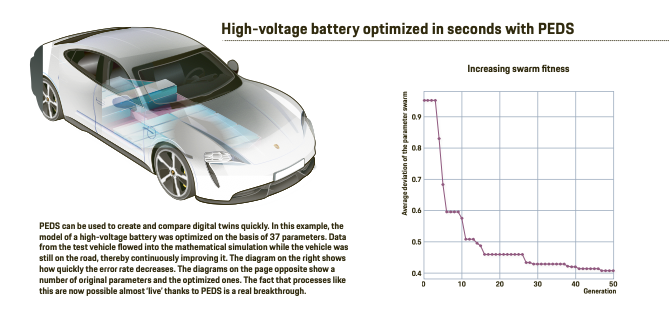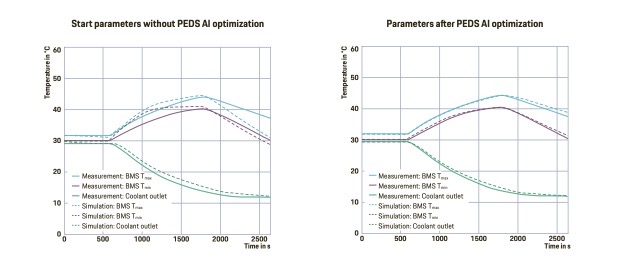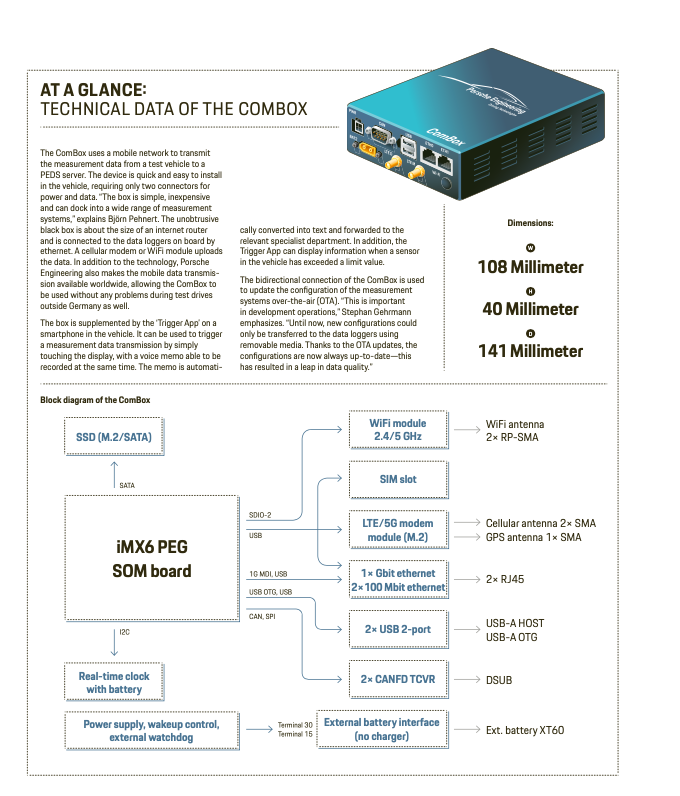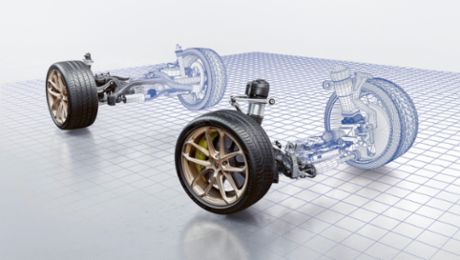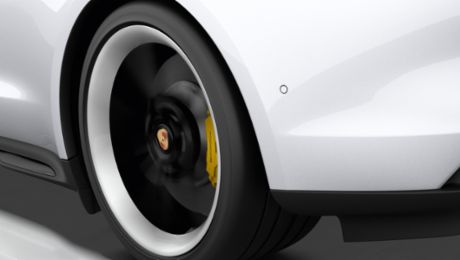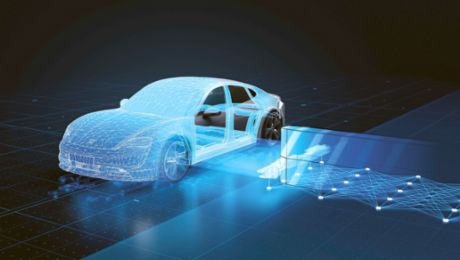The tradition at Porsche is for a new vehicle model to be tested not only by the development engineers, but also by many staff in the testing and quality departments. The testers can now provide their feedback even faster: anyone who finds an optimization opportunity turns off the vehicle, taps their smartphone and records a voice memo. For example: “Seat heating in level 1 too warm.” A few moments later, the department responsible receives an email with the comment, which has been automatically converted into text. The engineers can also access all the measurement data from the vehicle, as a mobile network is used to send it to a central server. This means that the feedback can be checked quickly and, if necessary, a software customization can be devel oped for the vehicle.
This live optimization is made possible by the Porsche Engineering Data Service (PEDS): This system connects the international test vehicles with the devel opers and thereby makes measurement data analysis considerably easier. To use the service, all that needs to be done in the test vehicle is to connect what is known as a ComBox in addition to the measurement system or data logger, which can be done in just a few simple steps. The device for wards the data from the integrated measuring devices to a PEDS server using a mobile network (LTE/5G) or WiFi. There, the data is processed and automatically evaluated. “This is a plugandplay digitization pro cess,” explains Björn Pehnert, Manager Digitization and initiator of the PEDS project at Porsche Engineering.
Dispensind with manual processes
The ComBox eliminates the need for many manual processes during the testing phase, for example during transfer of the measured values that were collected: a data logger in the vehicle, for example, records a significant volume of data each and every minute, capturing camera images, pressure and temperature data as needed in addition to the communication between the control units. Previously, removable media were used to transfer the measurement data to stationary PCs (readout stations) automatically. “Data loggers provide raw data that can only be eval uated after conversion,” explains Stephan Gehrmann, Manager Automation Measurement Technology depart ment at Porsche AG. In the final step, the developers selected the relevant data and analyzed it interactively. If testing was performed at a different location and a business trip was necessary, several days could pass before the first findings from a test drive were available.
Thanks to PEDS, data transfer and analysis now takes only minutes. One factor that saves time is the fact that the ComBox transmits measurement data so swiftly: The delay only totals 15 to 20 seconds for small volumes of data. Another factor is that all subsequent work steps now proceed automatically: PEDS converts the raw data and filters out the data that is relevant to the department. For example, the interior climate plays no role in chassis optimization. Finally, automatic analysis is carried out. For this process, the tools already in use at the specialist departments are integrated into the overall solution. “We didn’t reinvent anything, but rather integrated the existing know-how into a digital process,” explains Pehnert. “For example, PEDS can automatically feed data into the existing simulation of a component.”
Automation not only ensures shorter response times, but also helps significantly build up the data-base at the same time, which is evaluated promptly and automatically. Around 150 test vehicles are already connected to the server by means of a ComBox, and by the end of the year around the same number again is expected to have been added. This means faster availability of data for developers – and this at all locations, since all the international measurement data flows into a common pool, for example into Porsche’s in-house measurement data and testing platform ‘Cluu’. Whereas each specialist department previously had only a handful of test vehicles at its disposal, other teams can now systematically supply the engineers with relevant data. To do this, the developers only need to have the authorizations necessary to use the data. An engineer in Weissach, for example, is actively alerted to an anomaly in measurement data collected by colleagues in Anting, China. This makes it possible to test and implement new functions much faster.
PEDS also makes it easier to create and compare digital twins, these being simulations of components. The developers at Porsche Engineering have created one such model of the high-voltage battery of an electric vehicle, for example. Its thermal response is exactly the same as a real power storage unit. This model with 37 parameters was optimized with the help of PEDS: data from the test vehicle flowed into the mathematical simulation while the vehicle was still on the road, allowing ongoing improvements to be made. The result: the error value – i.e. the deviation between the real and simulated behavior of the battery – was halved. “The fact that processes like this are now possible ‘live’ is a real breakthrough,” says Pehnert.
Digital Optimization Loops
Because the digital twin of a component operates so realistically, it can effectively supplement real experiments and in some cases actually replace them altogether. It can be used, for example, to optimize the design and arrangement of the cooling plates in the high-voltage battery. To actually build all the options in this case would be impossible. “Digitally, however, the optimization loops can be run in seconds,” Pehnert explains. “Even the response of the battery in a prototype that doesn’t even exist yet can be simulated and perfected.”
To optimize driving comfort, test vehicles are often equipped with accelerometers. In some cases, they are secured in places that can only be reached when the vehicle is disassembled. During the test drive, sensors may occasionally shift slightly. This is a tricky situation, because the sensor concerned usually doesn’t fail completely, but continues to provide data. While the data stills seems plausible, it’s no longer reliable. “Even an experienced engineer often fails to recognize this,” explains PEDS developer Jonas Brandstetter from Porsche Engineering. In the past, errors like this were only identified weeks after the drive, which meant that testing had to be repeated – requiring enormous efforts, particularly when testing in remote areas.
PEDS ensures this can no longer happen: The system checks the measurement data for anomalies while the vehicle is still on the road. This is done by using an AI algorithm on the server, which has learned from a few data sets what a correct sensor signal looks like, enabling it to detect erroneous measurements. If the algorithm fails, the test engineer receives a push message on the smartphone and can cancel the test run.
PEDS has already been successfully tested in 15 use cases across all disciplines – from chassis optimization to global defect analysis at quality stations. But the system’s potential is far from exhausted. “We are now looking at scaling it up,” reports Pehnert. Setting up a network integrating the Volkswagen Group’s measurement data management system is therefore currently on the agenda. PEDS is already connected to the ‘Cluu’ measurement data and test platform. Access to the measurement data from Porsche’s data loggers is already available here. There are also plans to further simplify the wireless transmission of measurement data. The idea is to use WiFi to transmit the data from the measuring devices to the Speech2Text smartphone in the vehicle, and from there to PEDS. In some calibration, this could obviate the need for a ComBox in the test vehicle.
Summary
The Porsche Engineering Data Service (PEDS) connects the test vehicles that are operating all over the world with the developers. Using the ComBox specially developed for this purpose, data can be sent to the PEDS servers almost in real time, where it is processed and automatically evaluated. This reduces the amount of work and shortens development times considerably.
Info
Text first published in the Porsche Engineering Magazine, issue 2/2022.
Author: Constantin Gillies
Photos: Andrew Timmins
Copyright: All images, videos and audio files published in this article are subject to copyright. Reproduction or repetition in whole or in part is not permitted without the written consent of Dr. Ing. h.c. F. Porsche AG is not permitted. Please contact newsroom@porsche.com for further information.

